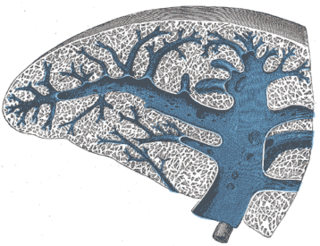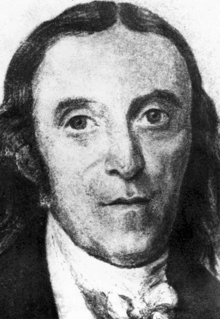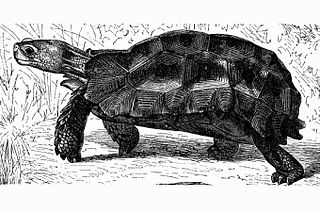
Reticular fibers, reticular fibres or reticulin is a type of fiber in connective tissue composed of type III collagen secreted by reticular cells. Reticular fibers crosslink to form a fine meshwork (reticulin). This network acts as a supporting mesh in soft tissues such as liver, bone marrow, and the tissues and organs of the lymphatic system.

White pulp is a histological designation for regions of the spleen, that encompasses approximately 25% of splenic tissue. White pulp consists entirely of lymphoid tissue.

The fibroelastic coat of the spleen invests the organ, and at the hilum is reflected inward upon the vessels in the form of sheaths. From these sheaths, as well as from the inner surface of the fibroelastic coat, numerous small fibrous bands, the trabeculae of the spleen, emerge from all directions; these uniting, constitute the frame-work of the spleen.
Periarteriolar lymphoid sheaths are a portion of the white pulp of the spleen. They are populated largely by T cells and surround central arteries within the spleen; the PALS T-cells are presented with blood borne antigens via myeloid dendritic cells.

The trabecular arteries are the name of the branches of the splenic artery after it passes into the trabeculae of the spleen, where it branches. When these arteries then reach the white pulp, and become covered with periarteriolar lymphoid sheaths, the name changes again to central arteries. Branches of the central arteries are given to the red pulp, and these are called penicillar arteries).

The trabecular veins are the largest veins inside the spleen. It drains the blood collected in the sinuses of the pulp.

Johann Salomo Christoph Schweigger was a German chemist, physicist, and professor of mathematics born in Erlangen.

The forest hinge-back tortoise, serrated hinge-back tortoise, or Schweigger's tortoise is a species of tortoise. Another species, Psammobates oculifer, also goes by the same name of serrated tortoise.

Schweiggers is a municipality in the district of Zwettl, in Lower Austria, Austria.
Franz Schweigger-Seidel was a German physiologist born in Halle an der Saale. He was the son of chemist Franz Wilhelm Schweigger-Seidel (1795-1838).
Franz Wilhelm Schweigger-Seidel ; born as Franz Wilhelm Seidel was a German physician and chemist born in Weißenfels. He was the father of physiologist Franz Schweigger-Seidel (1834–1871).

August Friedrich Schweigger was a German naturalist born in Erlangen. He was the younger brother of scientist Johann Salomo Christoph Schweigger (1779-1857).

Mesoclemmys is a South American genus of turtle in the Chelidae family.

Mesoclemmys gibba, known as the toadhead turtle or gibba turtle, is a small side necked turtle found in a wide area of South America, in Peru, Ecuador, Colombia, Venezuela, Trinidad, Guyana, Surinam, Paraguay, and parts of Brazil.

Salomon Schweigger was a German Lutheran theologian, minister, anthropologist and orientalist of the 16th century. He provided a valuable insight during his travels in the Balkans, Constantinople and the Middle East, and published a famous travel book of his exploits. He also published the first German language translation of the Qur'an.
Schweigger is a German surname. Notable people with the surname include:

Adanson’s mud turtle is a species of turtle in the family Pelomedusidae. The species is endemic to central Africa.

Friedrich Traugott Kützing was a German pharmacist, botanist and phycologist.
The Journal für praktische Chemie, was a German-language scientific journal for chemistry. The journal was founded in 1828 by Otto Linné Erdmann (1804–1869) as the Journal für technische und ökonomische Chemie, the oldest chemical trade journal in Germany. From 1828 to 1869 Erdmann was the editor, along with Franz Wilhelm Schweigger-Seidel, Richard Felix Marchand, and Gustav Werther. From 1870 to 1884 Hermann Kolbe was the editor-in-chief. From 1879 to 1884 Ernst von Meyer worked as co-editor under Kolbe and became editor-in-chief upon Kolbe's death in 1884 and continued in that capacity until his own death in 1916. Beginning in 1917 the journal was edited by Julius Bredt, Theodor Curtius, Karl Elbs, Otto Fischer (1852–1932), Fritz Foerster, and Berthold Rassow with August Darapsky as editor-in-chief. Beginning in 1953 the Journal für praktische Chemie was published by the Chemische Gesellschaft der DDR.














